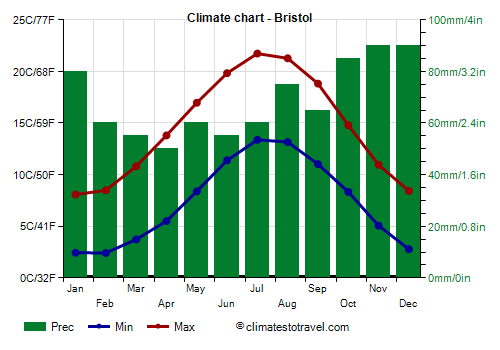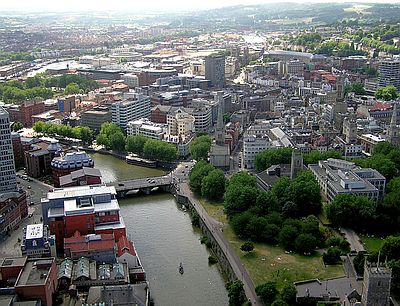Select units of measurement for the temperature and rainfall tables (metric or imperial).
Average weather, temperature, rainfall, sunshine hours

The climate of Bristol is
oceanic, with quite cold, rainy winters and mild, relatively rainy summers.
The city is located in South West England, 10 km (6 mi) away from the coast. Bristol Harbor overlooks the Severn Estuary, which then widens into the Bristol Channel, which separates England from Wales.
Winter is not very cold, but the sky is often cloudy, the humidity is high and there are periods when the wind blows moderate or strong. The rains are frequent.
Snow is rare, but can occasionally occur. On the coldest nights of the year, the temperature generally drops to around -6/-7 °C (19/21 °F), but can sometimes drop to lower values. In nearby Long Ashton, the temperature dropped to -14.5 °C (6 °F) in January 1982.
In
summer, temperatures are generally mild or cool. It can also rain, albeit a little less often than in winter.
However, hot periods cannot be ruled out, usually of short duration. In Long Ashton, the temperature reached 33.5 °C (92.5 °F) in July 1976 and in August 1990. More recently, at Filton airport, it reached 34.5 °C (94 °F) in July 2006.

Best Time
The best time to visit Bristol is the summer, or more generally
from mid-May to mid-September: temperatures are generally good for outdoors activities, although it's better to bring an umbrella, and a sweatshirt or sweater for the evening or for cool days.
Bristol - Climate data
In Bristol, the
average temperature of the coldest month (January) is of
5.3 °C, that of the warmest month (July) is of
17.6 °C. Here are the average temperatures.
Bristol - Average temperatures (1991-2020) |
| Month | Min | Max | Mean |
|---|
| January | 2.4 | 8.1 | 5.3 |
|---|
| February | 2.4 | 8.5 | 5.5 |
|---|
| March | 3.7 | 10.8 | 7.3 |
|---|
| April | 5.5 | 13.8 | 9.7 |
|---|
| May | 8.4 | 17 | 12.7 |
|---|
| June | 11.4 | 19.8 | 15.6 |
|---|
| July | 13.4 | 21.7 | 17.6 |
|---|
| August | 13.2 | 21.3 | 17.2 |
|---|
| September | 11 | 18.8 | 14.9 |
|---|
| October | 8.3 | 14.8 | 11.6 |
|---|
| November | 5.1 | 11 | 8 |
|---|
| December | 2.8 | 8.4 | 5.6 |
|---|
| Year | 7.3 | 14.5 | 10.9 |
|---|
amounts to
820 millimeters per year: so, it is at an intermediate level. It ranges from
50 millimeters in the driest month (April) to
90 millimeters in the wettest ones (November, December) Here is the average precipitation.
Bristol - Average precipitation| Month | Days |
|---|
| January | 80 | 13 |
|---|
| February | 60 | 10 |
|---|
| March | 55 | 10 |
|---|
| April | 50 | 10 |
|---|
| May | 60 | 10 |
|---|
| June | 55 | 10 |
|---|
| July | 60 | 10 |
|---|
| August | 75 | 11 |
|---|
| September | 65 | 10 |
|---|
| October | 85 | 13 |
|---|
| November | 90 | 15 |
|---|
| December | 90 | 13 |
|---|
| Year | 820 | 136 |
|---|
The
sea temperature ranges from
9 °C in March to
16 °C in August, September. Here are the average sea temperatures.
Bristol - Sea temperature| Month |
|---|
| January | 10 |
|---|
| February | 9.5 |
|---|
| March | 9 |
|---|
| April | 10 |
|---|
| May | 11.5 |
|---|
| June | 13 |
|---|
| July | 15 |
|---|
| August | 16 |
|---|
| September | 16 |
|---|
| October | 15 |
|---|
| November | 13.5"> |
|---|
| December | 11.5 |
|---|
| Year | 12.6 |
|---|
There are on average around 1660
sunshine hours per year. Here are the average hours of sunshine per day.
Bristol - Sunshine hours| Month | Average | Total |
|---|
| January | 2 | 60 |
|---|
| February | 3 | 80 |
|---|
| March | 4 | 125 |
|---|
| April | 6 | 175 |
|---|
| May | 6.5 | 205 |
|---|
| June | 7.5 | 220 |
|---|
| July | 7 | 220 |
|---|
| August | 6 | 190 |
|---|
| September | 5 | 155 |
|---|
| October | 3.5 | 110 |
|---|
| November | 2.5 | 70 |
|---|
| December | 2 | 55 |
|---|
| Year | 4.5 | 1660 |
|---|